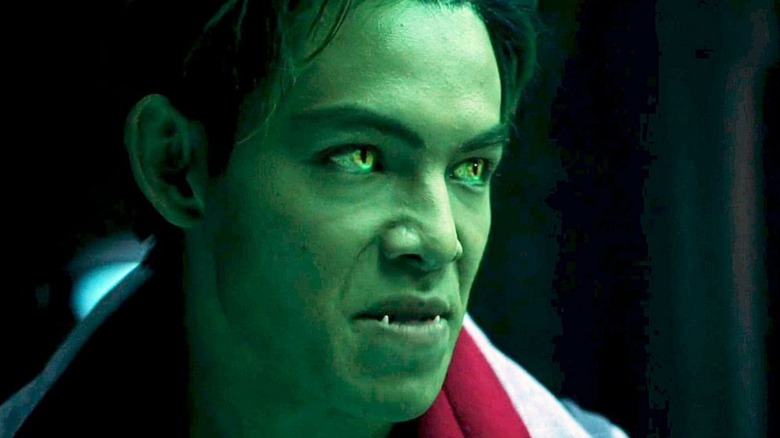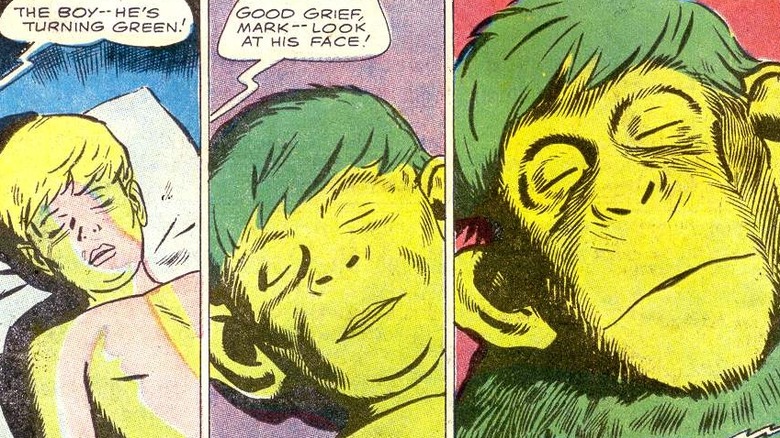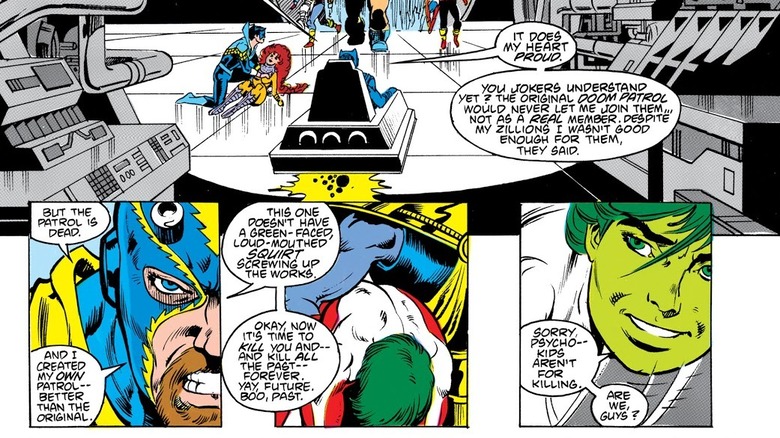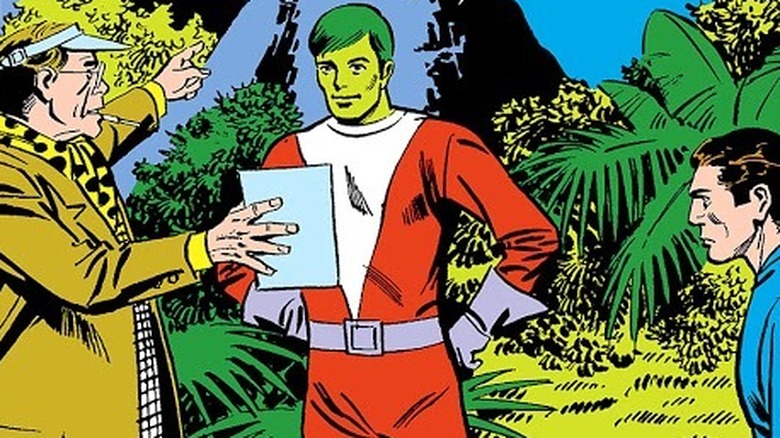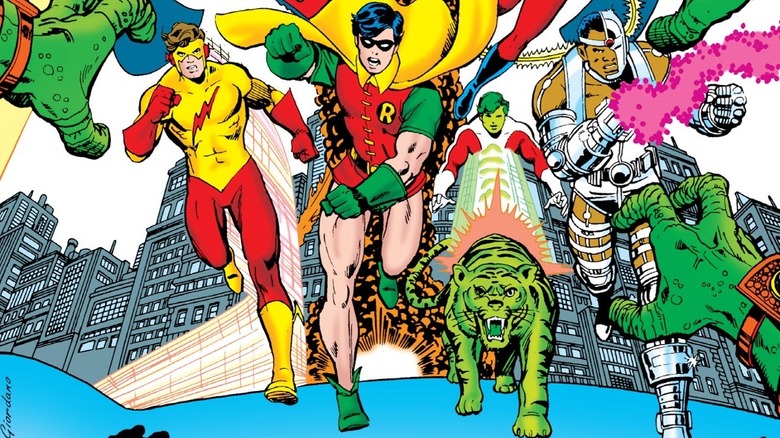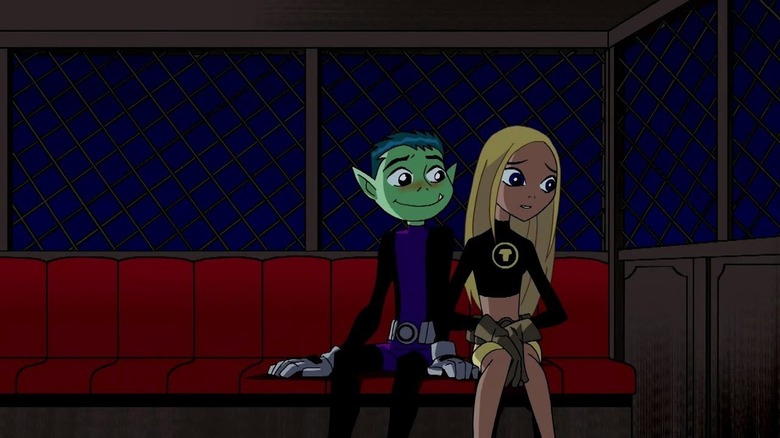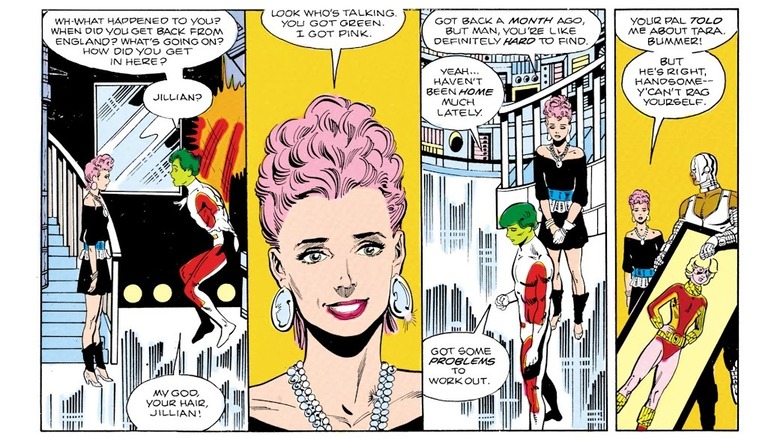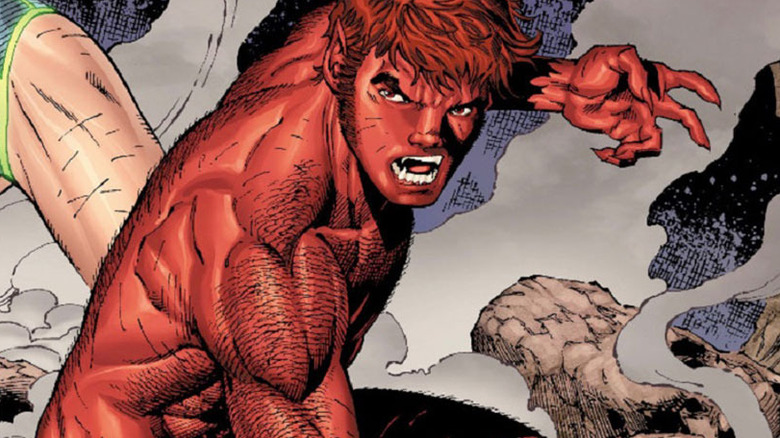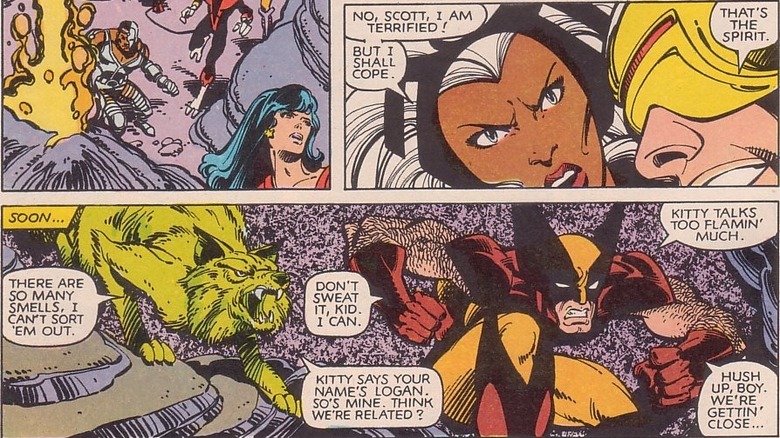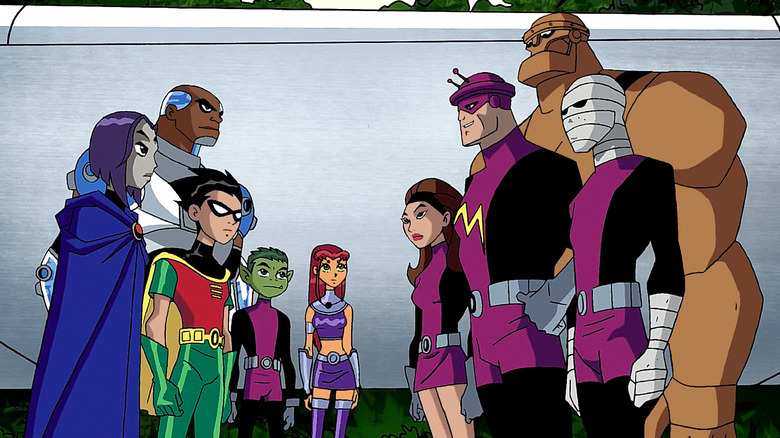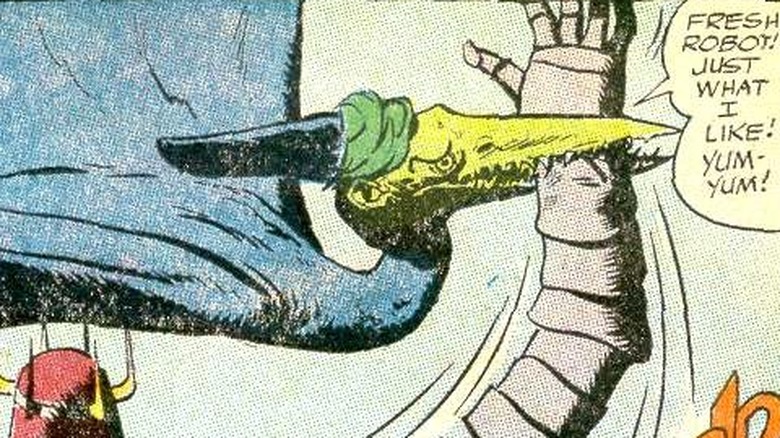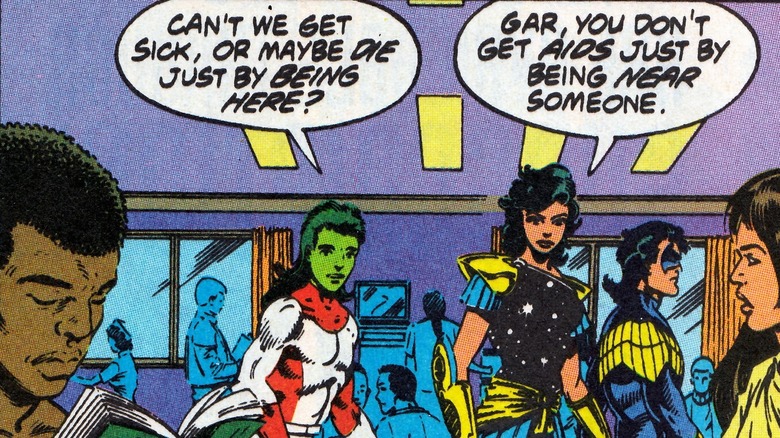11 Things You Didn't Know About DC's Beast Boy
If you were a kid anytime from 2003 forward, you likely grew up with green-skinned shapeshifter Garfield Mark "Gar" Logan, who first joined the New Teen Titans under the alias Changeling but who's better known, especially to 21st-century TV audiences, as Beast Boy.
DC introduced a shapeshifter named Beast Boy in September 1964's "Adventure Comics" #324. That incarnation was as an alien from the planet Lallor who turned villain, then hero, before being killed off in "Adventure Comics" #339. About a year later, Arnold Drake and artist Bob Brown created Garfield Logan, who debuted as a different Beast Boy in "Doom Patrol" #99. The goal, as Drake explained in "Comics Interview" #16, was to add some youth appeal to the title, with a relatable kid who talked back to his elder teammates.
Gar's role as the lighthearted smart-aleck of any team, who nonetheless wishes his teammates would take him more seriously, has remained relatively stable since then, give or take some traumatically dysfunctional relationships and cringeworthy turns as a borderline sexual predator. With third seasons of both the "Titans" and "Doom Patrol" live-action series both airing this fall, there's no time like now to learn more about Beast Boy.
Cured of "Green Fever"
Garfield Logan's life has always been marked by freak occurrences of good fortune that offset extended stretches of despair. As a child, Gar lived with his abusive parents, Mark and Marie Logan, in the fictional African country of Lamumba, where they were developing a "reverse evolution" process to bring back extinct creatures. That's where Gar contracted the rare virus Sakutia, also known as "Green Fever."
Because Sakutia is fatal for every species except the West African green monkey, Mark Logan subjected his son to an untested experiment, turning him into a West African green monkey for 24 hours to cure his illness. This also turned Gar's skin, eyes, and hair green, and gave him the ability to "Animorph" into a menagerie of animals.
In the "Young Justice" animated series that began in 2010, Gar gained both his all-green hues and his ability to shapeshift from a blood transfusion from Miss Martian after he was injured in an explosion, presumably because contracting a deadly disease involving West African monkeys became way less okay of an origin after 1981 (more on that later).
One unhappy family after another
Mark and Marie Logan's subsequent deaths in a boating accident left their son convinced that he could have prevented their deaths, but that was just the beginning of Garfield Logan's traumas. After Gar was rescued from kidnappers, his court-appointed guardian, Nicholas Galtry, plotted to kill him upon realizing that his own embezzlement from the Logan estate would be exposed if Gar were allowed to reach the age when he could receive his inheritance. Galtry's homicidal hirelings were foiled by the Doom Patrol, whose husband-and-wife members Mento (Steve Dayton) and Elasti-Girl (Rita Farr) stepped in to serve as Gar's adoptive parents.
Dayton had his own fortune, but was a less-than-nurturing father, even before the helmet he'd created to enhance his mental abilities drove him mad. After Rita died with the entire active-duty lineup of the Doom Patrol, Dayton blamed Gar for their deaths, until Raven temporarily corrected Dayton's mental problems.
Even setting aside how aggressively inappropriate an environment the Doom Patrol was for a child's upbringing, Dayton was destined to be a bad dad even before he hotwired his own brain like a stolen car, and the Doom Patrol's deaths arguably fed Gar's developing abandonment complex; he's rarely strayed far from the Titans since joining the team (before you ask: In the comics, Gar's future Titans teammate Cyborg never served on the Doom Patrol, even though he would have been welcome company).
A Hollywood hero, but rarely a high-roller
Rather than hide his inhuman appearance, Garfield Logan took advantage of it to get cast as "Lt. Tork" — an alien character obviously modeled after Mr. Spock, and a role for which Gar did his own stunts and special effects — in the sci-fi TV series "Space Trek: 2022," produced by the fictional Mammoth Studios, and ultimately canceled due to trademark infringement lawsuits from both "Star Trek" and "Space: 1999."
Not that Gar needed the money, since in addition to the Logan estate and Dayton's wealth, Rita Farr — an Olympic gold medalist and a Hollywood actress — saved up her own chunk of change, leaving Gar one of the richest superheroes in DC Comics. Even fellow Titan Dick Grayson, a former Robin and the legal ward of Bruce Wayne, pointed out how well-off Gar remains. And yet, for most of his life, Gar has refrained from dipping into his inheritance, and when he has indulged in a lavish lifestyle, he's soon grown tired of its emptiness.
If one were to guess which Titan was least financially equipped to live on their own, the safest bet would surely seem to be the kid who voluntarily spends his spare time at the crowded T-shaped building that serves as a dormitory for young superheroes, who routinely squabble over calling "dibs" on the entertainment center (also, Gar's choice of civilian careers arguably reflects his genuine affection for his adoptive mother, Rita).
Changing into Changeling
Garfield Logan received a rare opportunity at a do-over and made his first appearance as a member of the same team twice, albeit as part of two different lineups. When the "Teen Titans West" made their debut in "Teen Titans" #50 in October of 1977, Gar was a founding member, still going by "Beast Boy." But when October 1980's "DC Comics Presents" #26 introduced the "New Teen Titans," whose own title debuted the following month, Gar had renamed himself "Changeling."
This was more than merely Gar adopting a new superhero nickname — it earned "New Teen Titans" writer Marv Wolfman and artist George Perez co-creator status on the character, as they made Gar one of the central characters of the team (and the title), while deepening his characterization, albeit with often-unflattering portrayals.
Fans of the 2003-2006 "Teen Titans" animated series take for granted that Beast Boy and Cyborg (Victor Stone) are best buddies, but Gar's class-clown antics in his early days as a Titan grated on the nerves of his teammates, including Vic, until Cyborg discerned that Gar's affectedly frivolous attitude masked deep-seated insecurities and existential fears of loss. The "New Teen Titans" also imbued Changeling with an occasionally shocking level of insensitivity, from getting wrapped up in his own trauma (and drama), as well as a horn-dog approach to women, all too common among comic-relief lotharios of the '80s.
Betrayed and heartbroken
For all his romantic aspirations, Garfield Logan's love life makes Geordi La Forge's holodeck dalliances with Dr. Leah Brahms seem relatively healthy.
The romantic tragedy shared by the comic book and cartoon versions of Beast Boy is Terra, the teenage earth-shaper whose initial alliance with the Titans ultimately led her to infiltrate and betray the team on behalf of the mercenary Slade Wilson, AKA Deathstroke the Terminator. The four-part "The Judas Contract" story arc, which ran through "Tales of the Teen Titans" #42-44 and the title's third annual issue, revealed that Terra sought to seduce and deceive Changeling all along in order to try and please Deathstroke. Meanwhile, the Terra who appeared in the second season of "Teen Titans" earnestly wanted to be a hero, and was won over by Beast Boy's funny, friendly charms in spite of herself, but was also misled by Slade, who offered to help her exercise better control over her dangerous powers.
Likewise, those introduced to Beast Boy and Raven through the "Teen Titans" cartoon are likely inclined to see them as the show's One True Pairing, while comics fans who recall the "Forever Evil" three-part story arc, which ran through "New Titans" #119-121, might feel more squeamish about Garfield Logan finding love with the goth girl whose dark magic once implanted him (and several other superheroes, to be fair) with the evil seed of her father, the demon Trigon.
Forever young
After Terra's death, Garfield Logan was comforted by the return of his original long-term love interest, Jillian Jackson, with whom he'd attended high school during his Doom Patrol days. But when Jillian reappeared in "Tales of the Teen Titans" #47 in October of 1984, it was with an '80s punk makeover, complete with pink hair and an attitude and wardrobe to match. Jillian resurfaced sporadically in Gar's life, her hair alternating between pink, blue, and other colors, but aside from flashback cameos, her last appearance was in "New Titans" #96, in April of 1993.
It makes sense for DC not to call attention to Gar's age by bringing Jillian back again, and to pair him off with Raven, since they're the only founding "New Teen Titans" who never permanently aged to adulthood, nor served on the Justice League, portrayals in alternate possible futures notwithstanding. Raven reverted to a teenager through magical de-aging, while Gar went from appearing to be in his early 20s in the early '90s, to writer-artist John Byrne complicating his timeline by reintroducing the Doom Patrol in 2004 as though those characters had never previously appeared in the DC Universe.
Amusingly, in spite of so often being cast as the youngest Titan, Gar routinely has the most body hair.
It's not easy being green (or purple, or red)
Garfield Logan's constrained aging hasn't precluded him from undergoing radical physical transformations over time. Originally, Gar turned into otherwise perfect, naturally-colored duplicates of actual animals, except with green-skinned, green-haired heads. Although the creative crew behind the "Doom Patrol" title apparently (and accurately) decided this was deeply stupid, they nonetheless had Gar conceal his secret identity by making his skin purple in his human form, but only when disguised as his superhero alter ego.
The Doom Patrol's typically twisted logic was that no one would connect the dots between the otherwise totally ordinary green kid and the purple superhero his same age who turned into green animals, in case anyone wondered how the same team of superheroes could manage to get themselves killed so many times.
After being implanted with Trigon's seed, Gar briefly transformed into demonic monsters, which the four-issue "Kingdom Come" miniseries, published under DC's Elseworlds imprint in 1996, echoed by recasting an adult Gar as "Menagerie," who could only shapeshift into imaginary and mythical creatures and could no longer return to his human form.
"The New 52" line-wide reboot of the DC Universe, from 2011-2016, temporarily recolored Gar from green to red to connect him to "The Red," which empowers and interconnects animalistic superhumans, including Justice League members Animal Man and Vixen, much like "The Green" does for plantlike heroes and villains like the Swamp Thing and the Floronic Man.
He hates being Beast Boy
Garfield Logan's Changeling alias, while less catchy than Beast Boy, highlights how much he's struggled, in both fiction and reality, to distinguish himself from similar characters. The Beast Boy name was pioneered by another (albeit short-lived) DC Comics teen, and attempts to age it up run into Beast Man and Beast, names already taken by "Masters of the Universe" and Dr. Henry "Hank" McCoy of Marvel's X-Men, respectively.
Gar nonetheless adopted Beast Man as an alias in the possible future of the "Forever Evil" line-wide crossover, which ran from 2013-2014 (and is unrelated to the previously mentioned "Forever Evil" story arc), after he'd swiped Buddy Baker's Animal Man alias in another possible future. In spite of its dystopian future, "Forever Evil" cast its adult Gar as a Justice Leaguer at last, albeit the last one left standing.
And in "The Uncanny X-Men and The New Teen Titans" single-issue crossover, jointly published by DC and Marvel in 1982, Gar asked Wolverine if they were related, since Wolverine's "real" name was still Logan back then. Even Gar's first name is shared by the comic strip cat "Garfield" and Garfield Lynns, AKA Batman's pyromaniac adversary Firefly. But it was "Tales of the New Teen Titans" #3, in August of 1982, that revealed Garfield Logan's former guardian, Nicholas Galtry, mocked the name Beast Boy so much that it was ruined for Gar.
And onscreen ...
Voice actor Greg Cipes is the longest-running (and arguably definitive) Beast Boy, having played him in the animated series "Teen Titans" from 2003-2006, "Teen Titans Go!" starting in 2013, and the third season of "Young Justice" (subtitled "Outsiders") in 2019. A vegetarian-turned-vegan, Cipes has told interviewers how proud he is that his Beast Boy also eschews eating meat, in one episode telling his fellow Titans, during an argument over which pizza toppings to order, that he's been most of the animals on the menu.
Beast Boy was the only team member in the 2003-2006 "Teen Titans" cartoon to receive central Titan status in two seasons; Terra's story arc unfolded during the 2nd Season, while the Brotherhood of Evil, the Doom Patrol's old foes, were the villains during Season 5. Beast Boy was also the only sidekick in that cartoon whose mentor(s) bothered to show up, with the Doom Patrol, led by Mento, guest-starring in the Season 5 premiere. Batman, the Flash, and Green Arrow not only remained absent, but were barely mentioned, aside from vague references.
In the live-action "Titans" series, which started in 2018, Ryan Potter plays a Beast Boy with green hair and pale skin who's traumatized from being tortured into breaking his vow never to kill. Potter's Beast Boy is also a former member of the Doom Patrol, although he's from a version of the team that's slightly out of continuity with the one featured in the "Doom Patrol" series.
Permutations of powers
While the Beast Boy who appears in the live-action "Titans" series could only transform into a tiger at first — and had to remove his clothes to do so — the comic book version of Garfield Logan not only comes equipped with suits that adjust to his shapeshifting, but has also learned to apply his powers in a variety of creative ways.
Gar can turn into any animal he's seen, either firsthand or via media, and can alter his body mass to match those animals, which gives him not only all those animals' non-human abilities (a gorilla's strength, a cheetah's speed, a bird's flight, a fish's aquatic breathing), but also an increased healing factor, enough to regrow limbs. Gar can also adopt the forms of multiple animals at once — from a swarm of bees to a cluster of barnacles — as well as alien beings, all while retaining his human intellect, memories and ability to speak.
Gar can become a hybrid of multiple animals, boasting all their abilities, but he loses control in such forms, and while he can physically mimic other people, writer and Changeling co-creator Marv Wolfman told interviewer Heidi MacDonald in "Comics Journal" #80 that he considered this ability useless, unless Gar attempted to impersonate Marvel's Hulk, since he'd stay green. To prepare Gar for the possible loss of his powers, Dick Grayson also honed his hand-to-hand combat skills, using martial arts training he'd received from Batman.
An incredibly ill-advised PSA
During the same early '90s timeframe that saw Death of the Endless talking about HIV and AIDS in a Neil Gaiman-written mini-comic that ran in a trio of DC Vertigo titles, DC Comics' superhero titles ran close to half a dozen different one-page comics seeking to clear up the unfortunately common misconceptions about HIV and AIDS at the time. Those PSAs featured characters as diverse as Robin (Tim Drake) and Alfred Pennyworth, Green Lanterns Hal Jordan and John Stewart, and Justice Leaguers Blue Beetle (Ted Kord), Booster Gold, and Fire, all followed by phone numbers for the National AIDS Hotline. Unfortunately, in his comic, Beast Boy is depicted as uninformed and prejudiced, forcing his teammates to explain how HIV and AIDS really works.
It was painfully well-intentioned, and given Garfield Logan's prevailing portrayals during that deeply uneven era of comics, its depiction of how Gar would have reacted to visiting the AIDS ward of a hospital back then was arguably in-character. But still, especially considering how Beast Boy acquired his powers (again, from contracting a deadly disease), his casually thoughtless prejudice makes you want to smack the taste out of his mouth even before you spot him rocking that abominable Billy Ray Cyrus mullet.
As patronizing as these try-hard, wannabe-hip comics were, one could argue it was the level of remedial education our collective societal ignorance had demonstrated we'd earned, which doesn't make it feel any better for modern fans of Beast Boy to be confronted with him behaving so much less than lovably, even if it was decades ago.
